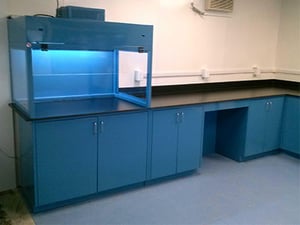To duct or not to duct: that is the question. Or at least a question manufacturers often face when deciding which fume hood to purchase.
Installing a fume hood in your laboratory is a major purchase - and necessary purchase - for your operation when you deal with toxic chemicals.
But, how do you know whether a ducted or ductless fume hood is best for your laboratory? Your budget, lab size and safety considerations all play a role in determining which is appropriate for meeting the needs of your lab and keeping the safety of your employees a top priority.
Here’s what you need to know about ducted and ductless fume hoods, including:
-
How each type works
-
The advantages and disadvantages of each
-
What you should consider before making a final decision.
How Each Type Works
One of the most reliable engineering pieces in a lab, ducted and ductless fume hoods both remove vapors, dusts, gases  and fumes that are created within the hood. As air flows into the the hood, these chemicals are removed via an exhaust system.
and fumes that are created within the hood. As air flows into the the hood, these chemicals are removed via an exhaust system.
But, how this process carries out differs between the two.
Ducted Fume Hoods
Considered the more standard choice, ducted fume hoods have ventilated enclosures and operate within the framework of your building infrastructure. They pull toxic fumes out of your laboratory through an HVAC system.
The construction of a ducted fume hood includes a base, work surface, hood, blower and ducting that carries the air outside. When installing, it’s important to consider whether your ventilation system has enough air to provide the necessary volume of ventilation to the hood.
Often, maintenance to the fume hood is performed as part of routine maintenance to the building. Generally, those who take care of the maintenance are in charge of the mechanical systems.
Ductless Fume Hoods
Ductless fume hoods, on the other hand, are considered more of an alternative choice. Though becoming more popular, they aren’t yet as widely used as ducted fume hoods.
Ductless fume hoods operate off a carbon filter system, which recirculates filtered air into your laboratory. Sometimes referred to as “recirculating range hoods,” this type of hood filters the air and then returns it back into a workspace.
Unlike ducted fume hoods, ductless hoods are self-contained and work well for laboratories where mobility is necessary. Laboratories that handle light to moderate chemical loads (no more than 10 chemicals per application, with a volume of approximately 500 mls or less) also may find ductless fume hoods to be a better choice operationally.
To understand further how a fume hood works, read our article, What Is A Fume Hood?
Advantages/Disadvantages Of Each
Whether it’s upfront cost savings, mobility or safety, both types of hoods provide distinct advantages and disadvantages in a laboratory space.
Ducted Fume Hoods
Ducted fume hoods are considered the safest for workers in laboratories, and many universities require this type of hood be installed in any facility that requires one to maintain worker and student safety. They often are the easiest for employers to maintain as well.
Other advantages include:
-
Can handle a variety of chemicals
-
Easy to operate and maintain
-
Little to no contamination in lab
On the other hand, ducted fume hoods may require other infrastructure improvements or additions, such as duct work, exhaust fans, changes to roofing elements and upgrades to mechanical systems. This can make them the more expensive choice up front.
exhaust fans, changes to roofing elements and upgrades to mechanical systems. This can make them the more expensive choice up front.
Other disadvantages include:
-
More difficult to install
-
Stationary in the lab
-
More difficulty in moving or relocating
-
Use more energy
Ductless Fume Hoods
Because of its self-containing fume hood design, ductless hoods are mobile - allowing workers to use the hood in different work areas depending on the need. They’re also a great option for labs that don’t handle as many chemicals or do not have the space for a full-size ducted unit.
Other advantages include:
-
Easy to install
-
Easily movable or relocatable
-
Use less energy
-
Less expensive upfront because there is not construction work needed
Ductless units, on the other hand, do have disadvantages that should be weighed carefully. Though they are a more cost-effective option from both an installation and operational perspective, one of the largest disadvantages is that workers are at a greater risk of chemical exposure because of its mobile design. Educating workers on the proper use of a ductless unit is critical in maintaining proper safety standards.
Other disadvantages include:
-
Handles limited chemicals
-
Requires certain filters for specific chemicals, with filter maintenance needed
-
Not as effective at removing chemical fumes
-
Not recommended for constant use
-
Can be noisy due to the internal blower
-
Cannot handle extreme heating of chemicals
What You Should Consider
Now that you better understand the differences between the two, as well as their advantages and disadvantages, you must determine which option is the best choice for your laboratory’s needs.
must determine which option is the best choice for your laboratory’s needs.
Here are some questions that may help you determine which is the better fit:
-
What chemicals will be used inside the hood?
-
How many different chemicals does your lab use?
-
Of these chemicals, are you working with small or large volumes?
-
Will the chemicals you are using adequately filter through carbon?
-
How experienced is your staff in working with chemicals? A university lab, for instance, may be filled with inexperienced students, providing a higher risk for exposure.
-
Does your building already have an HVAC system?
-
If so, is there a team in place to manage it and provide maintenance?
-
Is mobility necessary for your operation?
-
What is your budget - both up-front and including installation and long-term expenses?
-
How quickly do you need the hood installed?
-
Do you anticipate your facility location changing in the future?
Answering these questions before you purchase a fume hood for your laboratory will help you weigh the advantages and disadvantages of each and determine which is a better fit for how your facility operates.
Bottom Line
Ducted and ductless fume hoods play a critical role in any laboratory, removing toxic fumes from the air that can expose your workers to life-threatening chemicals.
No matter what, laboratory safety and workload should be your top considerations for any laboratory furniture. While you’ll likely take into consideration financial costs as well, keep in mind that the overall cost can change dramatically from the initial upfront fees through installation and subsequent maintenance.
An expert fume hood manufacturer can further help you navigate your options and determine which style of fume hood is best to meet your project specifications, budget and safety concerns.


